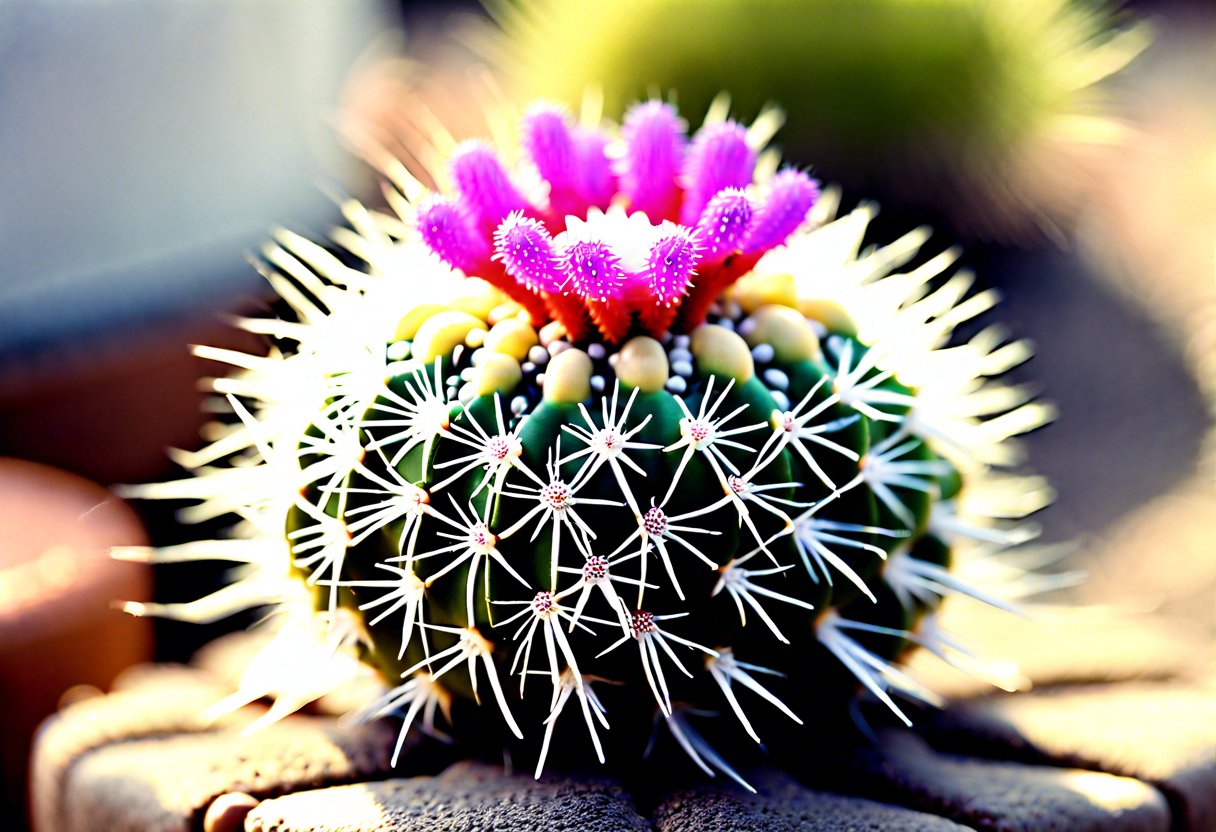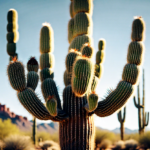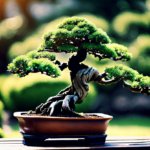Characteristics of the Pincushion Cactus (Mammillaria)
When it comes to unique and charming succulents, the Pincushion Cactus, scientifically known as Mammillaria, stands out for its distinctive features and fascinating appearance. This delightful cactus belongs to one of the largest genera in the Cactaceae family, boasting over 200 recognized species that vary in size, shape, and flower colors. The name "Pincushion" aptly describes its appearance, as these cacti typically form compact, globe-shaped clusters that resemble pincushions adorned with colorful spines.
One of the most striking characteristics of the Pincushion Cactus is its dense covering of radial spines that can range in color from white and yellow to red and brown, creating a visually appealing display. These spines not only serve as a protective barrier against predators but also help the cactus minimize water loss by providing shade and reducing airflow around the plant. Some species of Mammillaria also produce beautiful, funnel-shaped flowers in shades of pink, red, orange, or yellow, adding a vibrant pop of color to their spiny exteriors.
In addition to their aesthetic appeal, Pincushion Cacti are relatively easy to care for, making them popular choices for both novice and experienced gardeners. These cacti are native to various regions across the Americas, from the southwestern United States to parts of South America, where they have adapted to thrive in arid environments with well-draining soil and ample sunlight. Their small size and compact growth habit make them ideal for cultivation in containers, rock gardens, or xeriscapes, where they can be showcased as unique focal points.
Furthermore, Mammillaria species are known for their slow growth rate, making them excellent choices for those seeking low-maintenance plants that require minimal intervention. With the right growing conditions and occasional waterings during the growing season, Pincushion Cacti can flourish and even produce offsets or "pups" that can be separated and propagated to expand your cactus collection. Whether you’re a seasoned succulent enthusiast or a beginner gardener looking to add a touch of desert elegance to your space, the Pincushion Cactus is sure to captivate with its endearing charm and resilient nature.
To learn more about cultivating and caring for Pincushion Cacti, visit The Spruce for expert tips and insights on succulent gardening.
Ideal Growing Conditions for Pincushion Cactus (Mammillaria)
Pincushion Cactus, scientifically known as Mammillaria, is a type of cactus known for its charming appearance and relatively low maintenance requirements. To ensure the healthy growth and development of your Pincushion Cactus, it is crucial to provide it with the ideal growing conditions. Here are essential factors to consider when cultivating this unique plant:
1. Light: Pincushion Cacti thrive in bright, indirect sunlight. Placing them near a south-facing window where they can receive ample sunlight is ideal. However, it’s important to protect them from intense midday sun, especially during the hot summer months, as it can lead to sunburn.
2. Temperature: These cacti prefer warm temperatures ranging between 70°F to 90°F (21°C to 32°C) during the day and slightly cooler temperatures at night. It’s crucial to avoid exposing them to temperatures below 50°F (10°C) as they are sensitive to cold.
3. Soil: Well-draining soil is essential for Pincushion Cactus. A mixture of cactus potting mix and perlite or coarse sand can provide the proper drainage they need to prevent root rot. Ensure the pot has drainage holes to avoid waterlogging.
4. Watering: Pincushion Cacti are drought-tolerant plants that do not require frequent watering. Water them deeply but infrequently, allowing the soil to dry out partially between waterings. Reduce watering during the winter months when they are in dormancy.
5. Humidity: These cacti prefer low to moderate humidity levels. Avoid placing them in areas with high humidity to prevent issues such as mold and rot. Adequate air circulation around the plant can also help prevent humidity-related problems.
6. Fertilization: Fertilize Pincushion Cactus sparingly during the growing season, typically from spring to early fall. A balanced cactus fertilizer diluted to half-strength can be applied once a month to promote healthy growth. Refrain from fertilizing during the winter months.
7. Potting and Repotting: Choose a shallow pot with good drainage for your Pincushion Cactus. Repot the cactus every 2-3 years in fresh cactus mix to refresh the soil and provide ample space for growth.
By ensuring that these ideal growing conditions are met, you can enjoy a thriving and beautiful Pincushion Cactus in your indoor or outdoor space. Remember to observe your plant regularly and make adjustments as needed to provide the best environment for its growth.
Common Pests and Diseases Affecting Pincushion Cactus (Mammillaria)
Pincushion cacti, scientifically known as Mammillaria, are generally resilient plants. However, they can still fall victim to various pests and diseases if not properly cared for. It is essential for plant enthusiasts to be aware of these potential threats to ensure the health and vitality of their beloved cacti.
One of the most common pests that affect Pincushion Cactus is spider mites. These tiny arachnids feed on the sap of the cactus, causing wilting and discoloration. To prevent spider mite infestations, regularly inspect your cacti for any signs of webbing or stippling on the plant’s surface. If detected, isolate the infected plant immediately to avoid the spread to other cacti.
Another pest to watch out for is mealybugs. These soft-bodied insects can be found in white cottony clusters on the cactus. Mealybugs pierce the plant’s tissue and feed on its juices, leading to stunted growth and yellowing of the cactus. To eliminate mealybugs, consider using natural predators like ladybugs or wiping the affected areas with rubbing alcohol.
Apart from pests, Pincushion Cactus are susceptible to diseases such as root rot caused by overwatering. Rotting roots can lead to a decline in the plant’s health and eventual death. To prevent root rot, ensure proper drainage in your cactus’s pot and allow the soil to dry out completely between waterings. If root rot is detected, trim off the affected roots and repot the cactus in fresh, well-draining soil.
Furthermore, bacterial and fungal infections can also pose a threat to Pincushion Cactus. Symptoms of these infections include black spots on the cactus’s body, mushy tissue, and overall decline in the plant’s appearance. To combat bacterial and fungal diseases, remove any infected parts of the cactus using a sterile knife and apply a fungicidal solution to prevent further spread.
By staying vigilant and proactive in caring for your Pincushion Cactus, you can effectively prevent and manage common pests and diseases that may threaten their health. Regular inspection, proper watering practices, and prompt intervention are key to ensuring your Mammillaria thrive in a pest and disease-free environment. For more information on maintaining healthy cacti, visit the The Spruce website.
Creative Uses of Pincushion Cactus (Mammillaria) in Landscaping
Pincushion cacti, scientifically known as Mammillaria, are versatile and attractive plants that can add a unique touch to landscaping projects. These small and globular cacti are native to Mexico and the southwestern United States, making them well-suited for arid and desert-like environments. Here are some creative ways to incorporate Pincushion cactus into your landscaping:
-
Rock Gardens: Pincushion cacti are perfect for rock gardens due to their small size and low maintenance requirements. Placing these cacti among rocks of different sizes and shapes can create a visually striking and natural-looking landscape. The contrast between the cacti’s spiky texture and the smooth rocks adds visual interest to the garden.
-
Container Gardens: Pincushion cacti thrive in containers, making them ideal for patio gardens or small outdoor spaces. You can mix and match different varieties of Mammillaria to create a diverse and colorful display. Placing the containers at varying heights can add depth to the arrangement.
-
Xeriscaping: Xeriscaping is a landscaping technique that focuses on water conservation and using drought-tolerant plants. Pincushion cacti are perfect for xeriscaping projects as they require minimal watering once established. By incorporating these cacti into your xeriscape design, you can create a sustainable and eco-friendly outdoor space.
-
Accent Plants: Pincushion cacti can serve as eye-catching accent plants in garden beds or along pathways. Their unique shapes and sizes make them stand out among other foliage, adding a touch of whimsy to the landscape. Planting them in clusters or rows can create a sense of rhythm and unity in the garden.
-
Living Walls: Creating a vertical garden using Pincushion cacti can be a creative and space-saving landscaping idea. By planting these cacti in a vertical arrangement on a wall or trellis, you can transform dull spaces into vibrant and living works of art. Ensure proper drainage and ample sunlight for the cacti to thrive in a vertical setting.
Pincushion cacti into your landscaping projects can bring a touch of the desert into your outdoor space. Whether you choose to plant them in rock gardens, containers, or vertical displays, these versatile cacti are sure to add beauty and interest to your landscape design. For more inspiration on using Pincushion cactus in landscaping, you can visit cactusinfo.net to explore a wide range of creative ideas and tips.
Tips for Propagating and Caring for Pincushion Cactus (Mammillaria)
When it comes to propagating and caring for your Pincushion Cactus (Mammillaria), there are a few key tips to keep in mind to ensure the health and vitality of these unique plants.
Propagation of Pincushion Cactus can be done through offsets, seeds, or cuttings. Offsets, also known as pups or plantlets, can be gently removed from the base of the mother plant and replanted in a well-draining cactus mix. Seeds can be collected from ripe fruit and sown in a sandy soil mix, kept consistently moist until germination. Cuttings can be taken from healthy stems and left to callus before planting in a suitable cactus mix.
When it comes to caring for your Pincushion Cactus, providing the right growing conditions is essential. These cacti thrive in bright light, so placing them near a sunny window or in a location with direct sunlight is ideal. However, be cautious of intense midday sun, as it can scorch the delicate cactus tissue.
Watering your Pincushion Cactus sparingly is crucial, as these plants are adapted to survive in arid conditions. Allow the soil to dry out completely between waterings, especially during the winter months when the cactus is dormant. Overwatering can lead to root rot and other issues, so err on the side of underwatering rather than overwatering.
Fertilize your Pincushion Cactus sparingly, using a diluted cactus fertilizer during the growing season. Too much fertilizer can cause salt buildup in the soil, leading to nutrient imbalances and other problems. A balanced fertilizer with a lower nitrogen content is ideal for cacti like the Pincushion Cactus.
Regularly inspect your Pincushion Cactus for signs of pests or diseases, such as mealybugs, scale insects, or fungal infections. If any issues are detected, isolate the affected plant and treat it promptly to prevent the spread to other cacti in your collection. Keeping your cacti clean and free from debris can also help prevent pest infestations.
By following these tips for propagating and caring for your Pincushion Cactus (Mammillaria), you can enjoy healthy, vibrant plants that will bring a touch of desert beauty to your home or garden. For more information on cactus care and propagation, visit The Spruce.
Conclusion
The charming Pincushion Cactus (Mammillaria) into your garden can truly elevate your landscaping with its unique characteristics and versatile uses. Recognized for its globe-shaped appearance, this cactus species boasts a variety of shapes, sizes, and spination patterns, making it a delightful addition for both indoor and outdoor settings. When cultivating the Pincushion Cactus, it is imperative to provide the ideal growing conditions to ensure its optimal health and growth. This includes ample sunlight exposure, well-draining soil, and occasional watering to mimic its natural habitat in arid regions.
Despite its hardy nature, the Pincushion Cactus is susceptible to certain pests and diseases that can impact its vitality. Keeping an eye out for common issues such as mealybugs, spider mites, and rot is essential in maintaining the cactus’s well-being. By practicing proper sanitation and promptly addressing any signs of infestation or disease, you can safeguard your Pincushion Cactus from potential harm and promote its longevity in your garden.
Beyond its practical benefits, the Pincushion Cactus offers a myriad of creative uses in landscaping design. Whether used as a focal point in a rock garden, a striking addition to a succulent arrangement, or a low-maintenance feature in a xeriscape design, this cactus species adds texture, color, and architectural interest to any outdoor space. Its ability to thrive in various climates and soil conditions further enhances its appeal for landscape architects and gardening enthusiasts alike.
For those looking to propagate and care for the Pincushion Cactus, following a few key tips can ensure success in nurturing this resilient plant. Propagation methods such as division, offsets, or seeds offer opportunities to expand your cactus collection and share the beauty of the Pincushion Cactus with others. When caring for established plants, light fertilization, periodic repotting, and proper water management can help maintain its health and vibrancy for years to come.
The Pincushion Cactus (Mammillaria) stands out as a captivating choice for individuals seeking a visually appealing, low-maintenance plant to enhance their landscape. With its distinct characteristics, adaptable nature, and creative versatility, this cactus species has earned its place as a beloved favorite among gardening enthusiasts worldwide. By understanding its unique needs, addressing potential challenges, and exploring its various landscaping possibilities, incorporating the Pincushion Cactus into your outdoor environment can bring a touch of desert beauty and charm to your surroundings.


